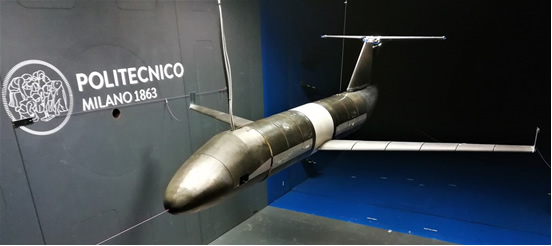Professional 3D Printing and Windform® composite materials used in the manufacturing of two innovative aero-elastic wind tunnel demonstrators

- Innovative wind-tunnel demonstrator– AFS project. The external aerodynamic sectors of the wing and the horizontal tail were 3D printed by CRP Technology using Carbon-composite Windform® XT 2.0. Courtesy of PoliMi
CRP Technology collaborated with the Department of Aerospace Science and Technology of the Politecnico di Milano (PoliMi) on the construction of parts for the aeroelastic wind tunnel demonstrators for “Aeroelastic Flutter Suppression (AFS)” e “GLAMOUR” projects.
The AFS project was launched by PoliMi and the University of Washington to test different active control system technologies aiming to attain Active Flutter Suppression.
The GLAMOUR project was focused on technological optimization and experimental validation of Gust Load Alleviation (GLA) control systems for an advanced Green Regional Aircraft manufactured by Leonardo Aircraft Division.
The contribution of CRP Technology involved the manufacturing of the external aerodynamic segments of the two wind tunnel demonstrators for both projects.
CRP Technology used professional 3D printing (selective laser sintering technology) and Carbon-composite Windform® XT 2.0 from its range of composite materials for LS, the Windform® TOP-LINE.
Windform® XT 2.0 was also used by CRP Technology to create the horizontal tail of the wind tunnel demonstrator for the AFS project.
Aerodynamic features correct and enhance the external shape of the wing and, at the same time, transmit the aerodynamic loads to the internal structure.
Prior to professional 3D printing, the aerodynamic sections of the wings were produced by carbon or glass fiber fabrics dry lamination, which were wrapped Styrofoam blocks suitably cut to match the wing’s shape.
This manufacturing process required much longer times and yielded lower quality surface finish.
Professional 3D printing has revolutionized the entire process of construction and verification of the parts allowing the following: faster production speed and possibility of optimizing the internal shape of these aerodynamic sections, allowing to make them as lightweight and stiff as possible.
MANUFACTURE OF AERODYNAMIC PARTS VIA 3D PRINTING
Through Selective Laser Sintering provided by CRP Technology, the PoliMi team was able to transfer resources from the construction phase to the design phase, obtaining better optimized components.
The wing components had to be lightweight, stiff, with parts characterized by thin layers (to obtain the lightest possible components, often the CAD design of the aerodynamic sectors is pushed to the limits) and with a smooth external surface.
During the test phase, the aerodynamic sections are not usually subjected to high stress since they do not form the primary structure of the aircraft, but perform a very important task: they transmit efficiently the aerodynamic forces to the flexible spar, acting as interface structure between the fluid (incoming air) and the internal structure of the wing. Therefore, it was fundamental that a good surface finish was achieved on the parts exposed to the incoming wind. The components were of reduced weight and were able to transmit the aerodynamic loads on the wing’s longitudinal spar.
The activity of CRP Technology’s 3D Printing department has been focused from the beginning on maximizing and achieving the targets required, providing full collaboration to the team of the Department of Aerospace Science and Technology of Politecnico di Milano.
Work began with an accurate analysis of the 3D and 2D files: Through their long-standing technological expertise, CRP Technology suggested PoliMi alterations that made it possible to optimize the geometries of the parts, reaching the required target weight and stiffness.
Through the know-how earned in over 20 years of activity serving the most demanding and performing industrial sectors, CRP Technology has been able to assist PoliMi in choosing the best technology and material to guarantee the success of the project: selective laser sintering and Windform® XT 2.0 Carbon-composite material from the Windform® TOP-LINE family of composite materials for LS technology (invented by CRP Technology itself).
Windform® XT 2.0 replaces the previous formula of Windform® XT in the Windform® TOP-LINE family of composite materials.
Windform® XT 2.0 features improvements in mechanical properties including +8% increase in tensile strength, +22% in tensile modulus, and a +46% increase in elongation at break. These mechanical properties have guaranteed the achievement of the required characteristics, ie stiffness, lightness as well as very smooth external surface.
Once received the .STP file with optimized geometries from PoliMi team, CRP Technology created in a short time the functional 3D printed aerodynamic components via selective laser sintering using Windform® XT 2.0.
Professional 3D printing, combined with Windform® XT 2.0 Carbon-composite material, proved to be the best choice: the 3D printed aerodynamic sections have successfully passed the control and testing criteria, and has fully complied with the requests and PoliMi’s standards.
FEATURES OF THE 3D PRINTED PARTS
Regarding the AFS project, Windform® XT 2.0 composite material combined with the LS technology, allow the wing sections to be designed including the elements for the connection to the main spar and, in case of the control surfaces, the hinges and the electric drivers.
Regarding the GLAMOUR project, Windform® XT 2.0 - thanks to the Carbon fibers – allows the combination of the vibration frequency targets together with the forced mass constrains.
Comments (0)
This post does not have any comments. Be the first to leave a comment below.
Featured Product

